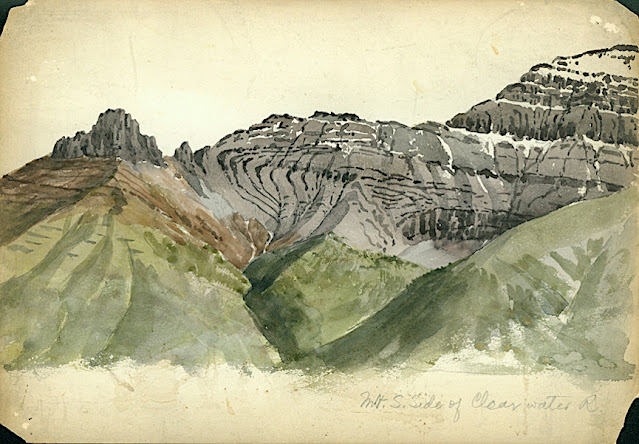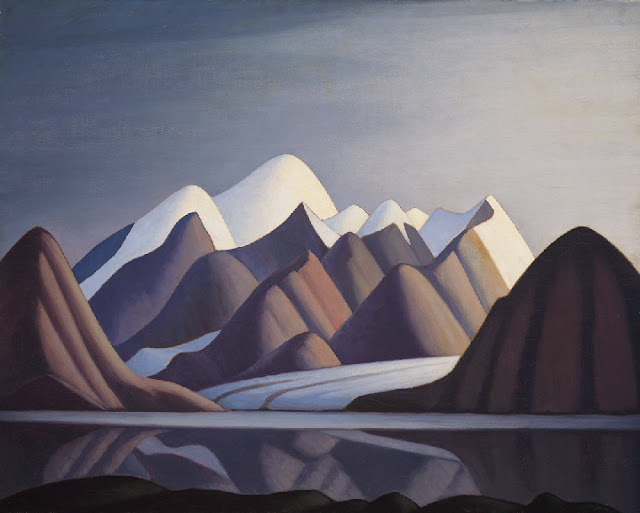ARTHUR P. COLEMAN (1852-1939)
Mount Coleman (3,135 m-10,285 ft)
Canada (Alberta)
In "Mountain un the Canadian rockies"
The mountain
Mount
Coleman (3,135 m-10,285 ft) mountain summit located in the upper North
Saskatchewan River valley in Banff National Park, in the Canadian
Rockies of Alberta, Canada. Its nearest higher peak is Cirrus Mountain,
4.46 km (2.77 mi) to the north. Mount Coleman is situated along the
east side the Icefields Parkway midway between Saskatchewan Crossing and
Sunwapta Pass.
Mount Coleman was named in 1898 after Arthur Philemon Coleman (1852-1939), a Canadian geologist and among the first white men to explore the area that is now Jasper National Park.(see below).
Like other mountains in Banff Park, Mount Coleman is composed of
sedimentary rock laid down from the Precambrian to Jurassic periods.
Formed in shallow seas, this sedimentary rock was pushed east and over
the top of younger rock during the Laramide orogeny. Based on the
Köppen climate classification, Mount Coleman is located in a subarctic
climate with cold, snowy winters, and mild summers. Temperatures can
drop below -20 °C with wind chill factors below -30 °C. Precipitation
runoff from Mount Coleman drains into tributaries of the North
Saskatchewan River.
The painter
Arthur Philemon Coleman was
a Canadian a geologist, professor, minerals prospector, artist, Rockies
explorer, backwoods canoeist, world traveller, scientist, popular
lecturer, museum administrator, memoirist and... one of Canada’s most
beloved scientist.
Arthur Coleman is a fine example of that rare
bird, a polished amateur artist whose drawings and paintings stand
comfortably beside those of many professionals. He was active during the
time when sketching and painting was ceding to photography the task of
recording the visible world. Although he was also a photographer,
painting was, for him, both a poetic and a descriptive pursuit, a way of
wrapping an artistic expression around a phenomenon he was interested
in or moved by. Thus motivated, Coleman's paintings give much joy and
command a good deal of respect. The more surprising, perhaps given that
he used to introduced himself more as a geologist than a painter.
Coleman travelled throughout the United States for professional
conferences as well as geological field work. He visited many of the
major American mountain ranges including: the American Cordillera
Mountains (Washington, Oregon and California); the Sierra Nevada
Mountains (California and Nevada); Yellowstone National Park (Wyoming,
Montana and Idaho); and the Appalachian Mountains (eastern United
States). Pleistocene glaciation had extended in Northern Europe as far
south as Berlin and London and covered an area of two million square
miles. Coleman also visited such countries as India, Australia, Brazil,
Argentina, Scandinavia, Bolivia, New Zealand, South Africa and Uruguay.
In his final years he made two expeditions to the Andes in Colombia, to
mountains in Southern Mexico and to two mountains in Central America.
He achieved the first ascent of Castle Mountain in 1884, and in 1907, he
was the first white man to attempt to climb Mount Robson. He made a
total of eight exploratory trips to the Canadian Rockies, wholly four of
them looking for the mythical giants of Hooker and Brown.
From 1901
to 1922, he was a Professor of Geology at the University of Toronto and
was Dean of the Faculty of Arts from 1919 to 1922. From 1931 to 1934,
he was a geologist with the Department of Mines of the Government of
Ontario. He was elected a Fellow of the Royal Society of Canada in 1900
and was its President in 1921. In 1929, he was appointed Honorary
Vice-President of the Royal Canadian Geographical Society.
"Mount Coleman" and "Coleman Glacier" in Banff National Park is named in his honor. He was awarded the Penrose Medal in 1936.
He planned to climb "his" mountain, "Mount Coleman"'in the Albertan
Rockies, and had also prepared a trip to British Guiana, but death
intervened.
He was author of:
- Reports on the Economic Geology of Ontario (1903)
- Lake Ojibway; Last of the Great Glacial Lakes (1909)
- The Canadian Rockies: New and Old Trails (1911)
- Ice Ages, Recent and Ancient (1926), and was co-author of Elementary Geology (1922).
- The Last Million Years (1941) edited by George F. Kay
2022 - Wandering Vertexes...
by Francis Rousseau



















